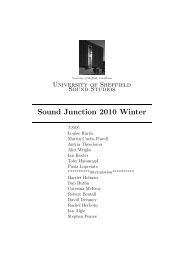Compositional Methods in Electroacoustic Music - Adrian Moore ...
Compositional Methods in Electroacoustic Music - Adrian Moore ...
Compositional Methods in Electroacoustic Music - Adrian Moore ...
You also want an ePaper? Increase the reach of your titles
YUMPU automatically turns print PDFs into web optimized ePapers that Google loves.
Paper 9 - False Awaken<strong>in</strong>g: A Multi-Channel Composition Embrac<strong>in</strong>g a Network of Technical<br />
and Aesthetical Issues<br />
17:00<br />
Tarren, Chris<br />
University of Birm<strong>in</strong>gham<br />
False Awaken<strong>in</strong>g is an electroacoustic work composed for a standard 5.1 speaker setup, which creates an immersive<br />
sonic environment experiment<strong>in</strong>g with vary<strong>in</strong>g levels of immersion, depth and movement of sounds<br />
around the listener. As a composer more used to work<strong>in</strong>g with an equally spaced r<strong>in</strong>g of eight loudspeakers,<br />
the limited number of full-frequency channels, coupled with the irregular spac<strong>in</strong>g between the different loudspeakers,<br />
presents a number of issues related to holes <strong>in</strong> the acoustic image. Common spatial behaviours such<br />
as envelopment by sound, movement of sources around the listener, and counterpo<strong>in</strong>t are no longer achievable<br />
with such ease or as conv<strong>in</strong>c<strong>in</strong>gly as with larger speaker arrays, and we as the composer are forced to re-th<strong>in</strong>k<br />
our compositional strategies <strong>in</strong> order to f<strong>in</strong>d a meet<strong>in</strong>g po<strong>in</strong>t between our musical language and the technical<br />
limitations of a loudspeaker configuration. By enter<strong>in</strong>g <strong>in</strong>to a dialog between our musical goals, technical<br />
toolbox and the characteristics of a system for presentation, I hope to enrich my compositions by exploit<strong>in</strong>g<br />
the idiosyncrasies of technical resources and diffusion systems so that they might enhance rather than work<br />
aga<strong>in</strong>st my musical language. A range of spatial audio and transformational techniques are explored, show<strong>in</strong>g<br />
how a solution comb<strong>in</strong><strong>in</strong>g different techniques can help <strong>in</strong> the articulation of different musical spaces, as<br />
well as ensure a similar quality of space when compos<strong>in</strong>g for different loudspeaker configurations. The paper<br />
shows how connect<strong>in</strong>g these technical and aesthetical issues was important <strong>in</strong> the success of this work and <strong>in</strong><br />
terms of th<strong>in</strong>k<strong>in</strong>g about further compositional developments<br />
2.5 Concert 2<br />
19:00<br />
Distant Early Warn<strong>in</strong>g - Side B (Re-Cut)<br />
O’Ria<strong>in</strong>, Damian<br />
This is a recent re-edit of a longer work that was completed <strong>in</strong> 2007/2008. It features an ‘energy landscape’<br />
comprised of repetition, pulsation, signals, data tones, feedback, drones, immersive noise fields, and textural<br />
backdrops. In brief, the ideas that <strong>in</strong>fluenced DEW-B relate to an underly<strong>in</strong>g relationship that exists between<br />
the phonograph, musique concrte, American m<strong>in</strong>imalism, and certa<strong>in</strong> styles of Germanic post-techno. The<br />
work could be <strong>in</strong>terpreted as a form of acousmatic m<strong>in</strong>imalism, <strong>in</strong>sofar as the use of elaborate gesture-laden<br />
pseudo-<strong>in</strong>strumental articulations, found <strong>in</strong> many contemporary acousmatic concert works is limited. Instead,<br />
the compositional use of blends, fades, cuts, removals, segues, and breakdowns suggest the manipulation of<br />
v<strong>in</strong>yl <strong>in</strong> a DJ set (albeit with touch of bruitisme). Pierre Schaeffer’s first experiments with the ‘sillon fermé’<br />
us<strong>in</strong>g shellac records, offers another po<strong>in</strong>t of reference. We know Schaeffer worked <strong>in</strong>itially (before tape) with<br />
this rather low-fi medium, one that was <strong>in</strong>tr<strong>in</strong>sically noisy. Yet, it would ultimately form the basis of one of<br />
the most significant developments <strong>in</strong> 20th century music: musique concrte. In the 1960s, three now famous<br />
members of the so-called ‘New York Hypnotic School’ presented drones, tape-loops, and repetition <strong>in</strong> the<br />
context of a m<strong>in</strong>imalistic aesthetic. Thirty years later, the locked groove would re-emerge when techno DJs<br />
employed it <strong>in</strong> their pursuit of relentlessly repetitive dance music. Additional po<strong>in</strong>ts of reference <strong>in</strong>clude the<br />
peculiar acousmatic proposition presented by a v<strong>in</strong>yl record<strong>in</strong>g of Cage’s 4’ 33” (a reduced listen<strong>in</strong>g experience<br />
that might perhaps draw ones attention to surface noise, rather than the actual record<strong>in</strong>g) and Christian<br />
Marclay’s use/misuse of record v<strong>in</strong>yl (an artist who <strong>in</strong> foreground<strong>in</strong>g surface noise attempted to jolt the listener<br />
out of the reification created by the medium of record<strong>in</strong>g).<br />
Granatum<br />
Stavropolous, Nikos<br />
Leeds Metropolitan University<br />
9



